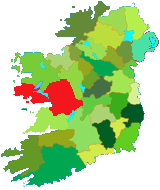
|
County
Galway from Samuel Lewis' Topographical
Directory of Ireland 1837
Galway is the second largest
county in area in the Republic of Ireland. The name comes
from the Irish gailimh: 'stony river'. It lies at the centre
of the west coast of Ireland.
The western third of the county is the rugged, scenic area
of Connemara, noted for its ponies. East Galway is mainly
a fertile lowland, well suited to agriculture.
At the boundary between
these two contrasting areas is the city of Galway, the largest
town in the county and in the province of Connacht.
The Atlantic Ocean forms Galway's western boundary, with the
huge inlet of Galway Bay. The River
Shannon which is renowned as a idealic cruising
area, separates it from Offaly and Tipperary to the east.
Mayo is to the north, Roscommon to the northeast, and Clare
to the south. Galway is 150 kilometer's from east to west
and 80 kilometer's from north to south. |
The landscape
of east Galway is mainly lowland, except where it rises to over
300 meters (994 Ft) in the Slieve Aughty Mountains
in the south. The mountains are sandstone, but the lowland lies
on limestone. Lowland soils are generally thin and dry and farmers
use the stones to build walls enclosing the fields. There are some
peat bogs near the Shannon and its tributary, the River Suck. The
River Clare drains most of the western part of the lowland to Lough
(lake) Corrib. Its outlet to the sea is the short River Corrib,
on which Galway City is sited.
Galway has a
Gaeltacht area, where people speak
Gaelic (Irish) as an everyday means of communication. The Gaeltacht
is mainly in the west of the county and includes the Arran
Islands. The population of the Galway Gaeltacht is around 30,000,
the largest in Ireland. The headquarters of the government department
Roinn na Gaeltachta, the development organization Udaras na Gaeltachta,
and the broadcasting station Radio na Gaeltachta are located. Many
children from other parts of Ireland go to the Gaeltacht in the
summer in order to attend Irish language schools. Many aspects of
traditional Irish life have survived in the Gaeltacht, especially
on the Aran Islands.
Service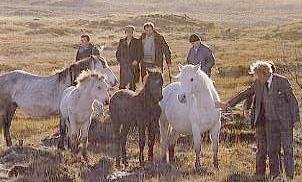 industries account for half of all
employment in Galway. Galway City is a major service centre. The
service industries, particularly education and health, employ as
many as the manufacturing industry. University College, Galway,
is part of the National University of Ireland. There is also a regional
technical college and a large regional hospital. Retail and wholesale
distribution is the second most important category of service industries.
Other services include administration and defense, financial services,
and transport.
industries account for half of all
employment in Galway. Galway City is a major service centre. The
service industries, particularly education and health, employ as
many as the manufacturing industry. University College, Galway,
is part of the National University of Ireland. There is also a regional
technical college and a large regional hospital. Retail and wholesale
distribution is the second most important category of service industries.
Other services include administration and defense, financial services,
and transport.
Tourism is of great importance to Galway,especially
in the  city and in Connemara. The Galway City suburb of Salthill
is a major seaside resort. Salthill has many
hotels, and guest
housed and serves as the tourist's gateway to Connemara. The
mountain and coastal scenery attracts many visitors and anglers.
The government has established the Connemara National Park to conserve
some of the landscape and wildlife. Major annual equestrian
events in the county include the Galway races, the Connemara
pony show in Clifden, and the Ballinasloe horse fair.
city and in Connemara. The Galway City suburb of Salthill
is a major seaside resort. Salthill has many
hotels, and guest
housed and serves as the tourist's gateway to Connemara. The
mountain and coastal scenery attracts many visitors and anglers.
The government has established the Connemara National Park to conserve
some of the landscape and wildlife. Major annual equestrian
events in the county include the Galway races, the Connemara
pony show in Clifden, and the Ballinasloe horse fair.
One of Ireland's major fishing ports is Rossaveal,
in west Galway. Shellfish are particularly important along the Galway
coast. The area of forestry is increasing, mainly in the uplands.
There is a forest park at Portumna. Peat is cut for fuel and there
is a small peat fired power station at Screeb, in Connemara. Craft
workers make ornaments from the mottled green Connemara marble,
extracted from local quarries.
The rugged landscapes of west Galway with
their peat bogs and heath lands contrast with the gentle, green
landscapes to the east of Lough Corrib. The land rises to 700 meters
in the Twelve Bens and Maumturk
Mountains. The highest peaks contain the mineral quartzite,
but there are other ancient rocks in the vicinity. A low-lying area
to the south lies mainly on granite. The coastline is fairly straight
along Galway Bay, but in the west it is deeply indented with many
bays and small islands. The
Aran Islands, formed of bare limestone, lie at the entrance
to Galway Bay. Most of the settlements in west Galway are along
the coast.
Claddagh
Ring.
The Claddagh ring is a traditional Irish
design originating in a fishing village called Claddagh just outside
Galway town, now swallow up's urban sprawl. The design as can be
seen is two hands presenting a crowned heart.
Claddagh rings were widely worn by woman
in the west of Ireland, the ring was often
the most valuable article the family possessed. They were usually
handed down from mother to daughter. The tradition was that if the
girl wore the ring on her right hand with the heart pointed towards
the nail, she was open to offers of marriage. And if she wore it
on the left hand with the heart pointed away from the nail she was
engaged to be married.
west of Ireland, the ring was often
the most valuable article the family possessed. They were usually
handed down from mother to daughter. The tradition was that if the
girl wore the ring on her right hand with the heart pointed towards
the nail, she was open to offers of marriage. And if she wore it
on the left hand with the heart pointed away from the nail she was
engaged to be married.
Patrick
Pearse.
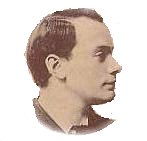 Set
alone on a little hill overlooking a small Lough is a tiny whitewashed
cottage. It was built in 1910 by Patrick
Pearse (1879-1916) And used by
his for holidays and to improve his Irish
Set
alone on a little hill overlooking a small Lough is a tiny whitewashed
cottage. It was built in 1910 by Patrick
Pearse (1879-1916) And used by
his for holidays and to improve his Irish
He was president of the provisional
government of the Irish Republic in 1916.
More information abour Patrick
Pearse
Lady
Augusta Gregory.
(1852-1932)
In 1896 while on a walking tour W
B Yeates met the wealthy widow Lady Gregory. Had this meeting
not taken place the Irish Literary Revival which resulted from it
may not have happened.
on a walking tour W
B Yeates met the wealthy widow Lady Gregory. Had this meeting
not taken place the Irish Literary Revival which resulted from it
may not have happened.
Born Isabella Augusta Persse, she spent her
youth at Roxborough House 8 miles from Coole. In 1880 she married
Sir William Gregory, a man 35 years her senior.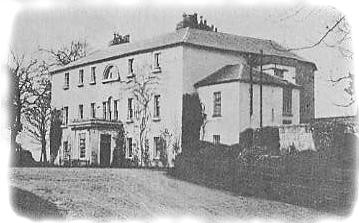 He had returned home to Coole house after a career in India.
He had returned home to Coole house after a career in India.
After his death in 1882 Lady Gregory who
had a keen interest in literature and Irish folklore pursued these
interests, she taught herself Irish by visiting local people and
talking to them, while doing this she collected stories and traditions.
She wrote poems, short stories and about 40 plays. It was in no
small way thanks to her that Dublin's Abbey theater was formed.
One of her books 'Lady Gregory's Complete
Irish Mythology' published by Bounty Books, can be thoroughly
recommended to anyone wishing to explore the rich heritage of Irish
Mythology.
She was a generous woman possessed of great
energy and talent, she died in 1932 and is buried in the new cemetery.
Queen
Maeve.
Maeve (Medb.) The legendary Queen of 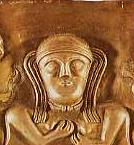 Connaught plays the role of an anarchic
goddess of war and fertility in Irish folklore and mythology. There
are many stories in which she features, these are usually to do
with the rivalry between Ulster and Connaught and involving the
great Ulster warriors Cuchulainn, Conall and Laoire. (See also Irish
Myths)
Connaught plays the role of an anarchic
goddess of war and fertility in Irish folklore and mythology. There
are many stories in which she features, these are usually to do
with the rivalry between Ulster and Connaught and involving the
great Ulster warriors Cuchulainn, Conall and Laoire. (See also Irish
Myths)
According to Irish mythology no king could
rule in Connaught unless he were married to Maeve who it was believed
held the key to the sovereignty in her person.
The illustration on the right is a panel
on the outside of the Gundrestrup Cauldron found in Denmark in 1891
It is said to be 1st century BC and represent Queen Maeve.
Maeve's most famous exploit is the invasion
of Ulster to capture the famous brown bull of Cuailbne 'Cooley'
in it she captures the bull and the Ulster hero Cuhullain is killed.
Ulster's revenge came some time later when
she is killed by Forbai son of king Conchobhar 'Connor' Mac Nessa.
Forbai discovered that Maeve bathed in a pool, he visited the pool
and measured the distance from a hiding place to where she bathed.
On returning to Eamain Macha in Ulster he practiced with a slingshot
until he could knock an apple from a pole at the same distance.
He made his way back to Galway and waited until Maeve came to the
pool, there he struck her on the forehead with a single shot, thus
Ulster was avenged.
Tourist
Information
Aras Failte
Forster Street
Galway
Co Galway
Tel +353 (0)91 537 700
E Mail
Web Site
|
Read about The
Arran Islands from Lewis Topographical Directory of Ireland.
Read about Galway
in 1837 from Lewis Topographical Directory of Ireland.
|